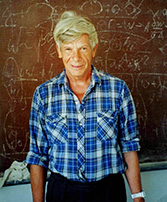Speaker
Description
It has been shown that non-Abelian vortex string supported in four dimensional (4D) ${\mathcal N}=2$ supersymmetric QCD (SQCD) with the U(2) gauge group and $N_f = 4$ quark flavors becomes a critical superstring. This string propagates in the ten dimensional space formed by a product of the flat 4D space and an internal space given by a Calabi-Yau non-compact threefold, namely, the conifold. The spectrum of closed string states of the associated string theory was obtained using the equivalence between the critical string on the conifold and the non-critical string on the semi-infinite cigar described by SL($2, \mathbb{R}$)/U(1) Wess-Zumino-Novikov-Witten model. This spectrum was identified with the spectrum of hadrons in 4D ${\mathcal N}=2$ SQCD.
In order to describe effective interactions of these 4D hadrons in this paper we study correlation functions of normalizable vertex operators localized near the tip of the SL($2, \mathbb{R}$)/U(1) cigar. We also compare our solitonic string approach to the gauge-string duality to the AdS/CFT-type holography for little string theories (LSTs). The latter relates off mass-shell correlation functions on the field theory side to correlation functions of non-normalizable vertex operators on the cigar. We show that in most channels holographic approach works in our theory because normalizable and non-normalizable vertex operators with the same conformal dimension are related due to the reflection from the tip of the cigar. However, we find that holography does not work for lightest hadrons with given baryonic charge.

